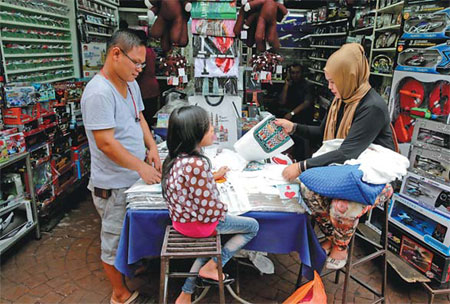Street keeps alive Chinese roots
Kuala Lumpur road a beacon for immigrant communities
Editor's note: China Daily continues its reports from neighboring countries in order to provide insight into topics relevant to China. In the third installment of our four-part series, we report on the history of Chinese Malaysians.
No traveler would want to miss Petaling Street, in the heart of Kuala Lumpur, yet few can recite its history.
The 500-meter-long thoroughfare has witnessed the ups and downs of generations of Chinese Malaysians over hundreds of years.
Like most Chinatowns, the street is decorated with red lanterns and paper cutouts, and packed with stores, restaurants and ancestral halls.
"Look at the street. It's exactly the same as Beijing's Wangfujing, right?" said Lee Chun Kong, 70, a local social activist. Each morning, he strolls along the street and greets peddlers and shop owners who he has known for decades.
Lee first visited Beijing 20 years ago. To him, Wangfujing Street, near the Forbidden City, symbolizes modern China's prosperity.
Lee said that "Chinatown", when applied to Petaling Street, is neither accurate nor welcome because it actually lowers the social status of Chinese Malaysians.
"It is where Chinese immigrants lived and conducted business in the early years, and therefore the street has taken on a traditional Chinese character. But since the 1920s, all three ethnicities in Malaysia (Chinese, Indian and Malay) have gathered here to make their living," Lee said.
"It is not literally a Chinatown anymore since nowadays most employees in the stores are workers from Indonesia, the Philippines and India," Lee said.
Kuan Ti Temple
In the middle of Petaling Street stands the century-old Kuan Ti Temple, which belongs to the equally old Kwong Siew Association of Selangor & Federal Territory. The temple, with burning joss sticks and candles, enshrines Kuan Kung, who is worshipped by Chinese around the world as a guardian deity of their businesses.
Lim Ah Peng, 49, grew up between the red columns of the temple. As a child, he used to play in the yard and hide behind the statues, watching sightseers and pilgrims stream out.
"In the morning, local Chinese drop by on their way to work to say a brief prayer. Later, tourists come for a glimpse of Chinese culture. Children come here in the afternoon for free lessons, and old friends gather after dinner to chat over a pot of tea," Lim said. "It is a place that somehow binds the Chinese communities."
Lim has spent his entire life at the temple. For years, he helped with chores and later was appointed by the association to take charge of the temple's daily affairs.
Wearing a shirt with a Chinese knot design, he noted that the temple, which was being revamped, was preparing for a year-end sacrificial ceremony.
"The temple is always jammed with worshippers on traditional festivals like Spring Festival and Mid-Autumn Day, but we never charge entrance fees like many temples in China do," he said. "Everybody is welcome to pray here for free."
The Kwong Siew Association, which owns and manages the temple, was established in 1888. It was formed by a group of Kwong Siew people, originally from 32 counties in Guangzhou and Zhaoqing, Guangdong province. It aimed to "strengthen the bonds of its members" and help fellow villagers after they had sailed across the ocean and settled in the capital city, rich in tin ore.
It gradually grew into one of the most influential Chinese township groups in Kuala Lumpur. Today, it has more than 1,000 members.
"Our forefathers came to Malaysia with the idea of making money and then returning home, but the fact is, most of them settled down," said Ho Chan Nam, president of the association.
"They started organizing associations based on their ancestral homes to take care of their offspring and newcomers.
"The groups, serving as hubs between the immigrants and China, provided a mail service, mediated local conflicts and helped to collectively bury the dead, as was the Chinese custom," Ho said. The association donated a considerable amount to support China's resistance to the Japanese invasion of the 1930s, he added.
Moreover, concerned that the English-speaking environment in Malaysia might undermine their children's cultural identity, in 1927 the Kwong Siew Association was among the first to launch free schools, whose mission was to instill Chinese studies in young minds so they would not forget their origins. It recruited more than 500 students at its peak in the 1950s.
"Later, due to social development and full-time schooling, many similar schools had to shut down, but our Kwong Siew Free School is the last one standing," said Lee, the social activist and former president of the association.
"Our school has faced pressures, such as funding and government policies. We were constantly told to shut it down. But as Chinese Malaysians, we know that on the issue of education, we cannot compromise, even if the school has only one student," he said.
Since the 1990s, Chinese Malaysian township groups have shown a growing interest in the government's policymaking process.
"We have to involve ourselves in politics to safeguard our rights. If the government is going to change policies on education or taxation, our associations will discuss, vote or protest to have our voice heard," Ho said.
puzhendong@chinadaily.com.cn
|
Customers look at fabrics at a craft store on Petaling Street. The 500-meter-long thoroughfare in Kuala Lumpur has witnessed the ups and downs of generations of Chinese Malaysians. Jiang Dong / China Daily |
(China Daily 02/15/2014 page6)















